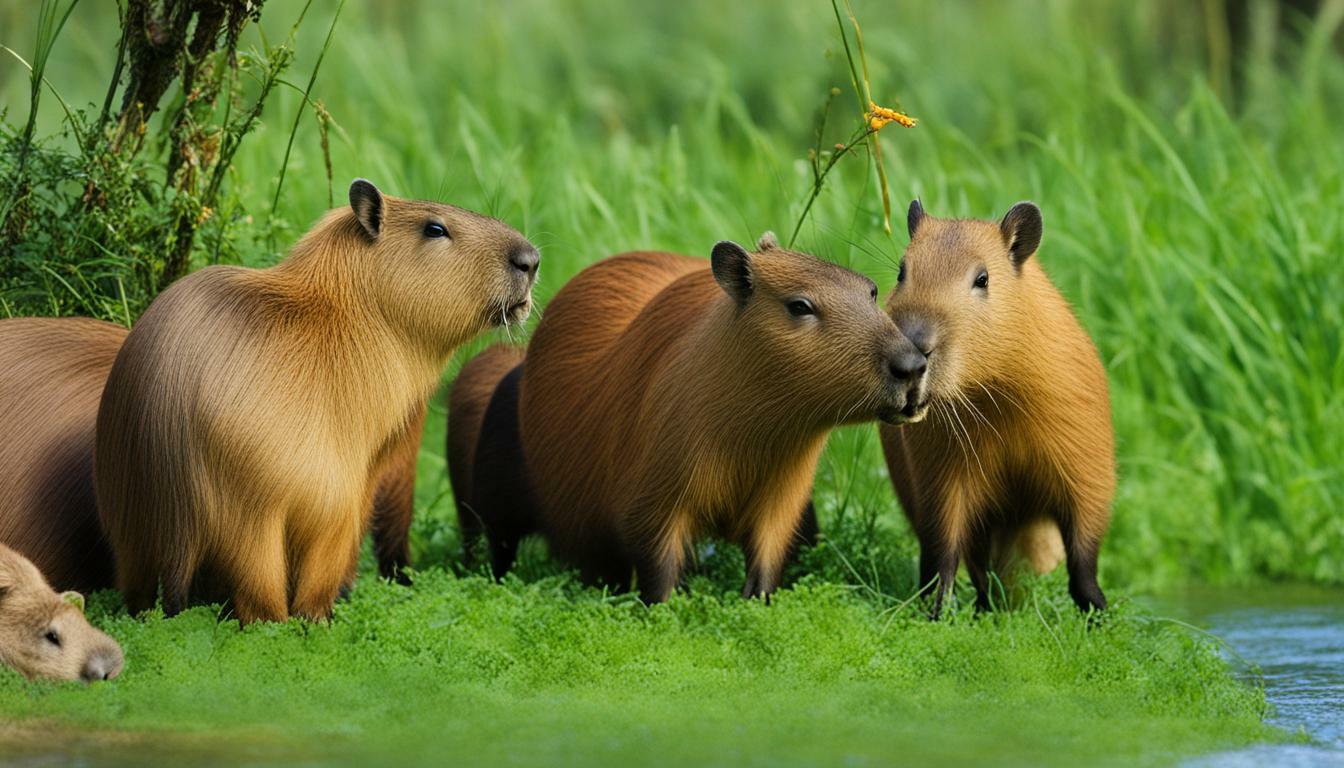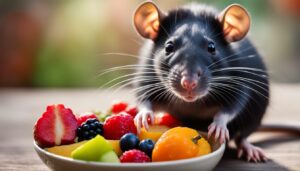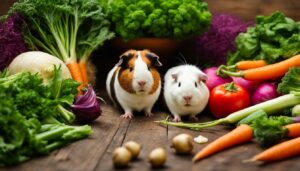Capybaras are herbivores, but let’s explore whether they incorporate meat into their diet. These fascinating creatures primarily feed on plants, grasses, and leaves, making them strict vegetarians. However, there are some factors worth considering when it comes to the possibility of carnivorous capybaras.
Key Takeaways:
- Capybaras are herbivores and consume a diet mainly consisting of plants, grasses, and leaves.
- They may consume fruits, vegetables, and berries in limited quantities.
- Their diet is low in protein but high in fiber.
- Capybaras have a unique habit of consuming their own feces, which provides them with additional nutrients.
- It is important not to feed capybaras meat, chocolate, sweeteners, or high-fat foods.
- In Venezuela, capybara meat is classified as fish during Lent due to its popularity as a delicacy.
Understanding the Capybara’s Diet
Capybaras have specific food habits that determine their diet and eating preferences. They are primarily herbivorous animals, meaning their diet consists mainly of plants, grasses, and leaves. These furry creatures are often found grazing near bodies of water, where they can easily access their preferred food sources.
“Capybaras mainly consume vegetation that grows near the water, such as aquatic plants, reeds, and grasses,” says Dr. Maria Lopez, a renowned zoologist specializing in capybara behavior. “They have a unique ability to digest tough plant fibers, which allows them to thrive on a diet rich in cellulose.”
While capybaras are mainly herbivores, they may also consume certain fruits, vegetables, and berries in limited quantities. However, their diet is low in protein and high in fiber, as their digestive system is specifically adapted to break down plant matter efficiently. It is important to note that capybaras should not be fed meat, chocolate, sweeteners, or high-fat foods, as these can be harmful to their health.
| Dietary Preference | Examples |
|---|---|
| Plants and Grasses | Aquatic plants, reeds, grasses |
| Fruits and Vegetables | Occasional consumption in limited quantities |
| Limited Consumption | Fruits, vegetables, and berries |
| Not Recommended | Meat, chocolate, sweeteners, high-fat foods |
“Capybaras have evolved to thrive on a plant-based diet, which provides them with the necessary nutrients and energy,” explains Dr. Lopez. “Their unique digestive system allows them to efficiently extract nutrients from plant matter, making them well-adapted to their natural habitat.”
Eating Behavior and Fecal Consumption
In addition to their plant-based diet, capybaras have a unique eating behavior. They are known to consume their own feces, which may seem unusual to humans but serves an essential purpose for these animals. The consumption of feces, also known as coprophagy, allows capybaras to extract additional nutrients and vitamins that were not fully absorbed during the initial digestion process.
“Capybaras have a specialized fermentation chamber in their digestive tract that helps break down cellulose and extract nutrients from their food,” says Dr. Lopez. “By consuming their own feces, they can further extract protein and vitamins, ensuring they obtain maximum nutrition from their diet.”
Overall, understanding the capybara’s diet and eating habits is crucial for their health and well-being. Providing them with a balanced diet of plant-based foods, while avoiding harmful substances, helps maintain their natural instincts and ensures they receive the proper nutrition they need to thrive.
Plant-Based Diet
Capybaras are primarily vegetarian, and their diet mainly consists of plants, grasses, and leaves. They are herbivorous animals that thrive on a diet rich in fiber. The large rodents are known to consume a variety of vegetation to meet their nutritional needs.
One of the key sources of food for capybaras are aquatic plants, including water hyacinths and water lettuce. They are often found near water bodies and enjoy munching on these plants, which provide them with necessary nutrients. Additionally, capybaras also feed on grasses and leaves found in their habitat. They graze on these plants to fulfill their appetite and maintain their energy levels.
In addition to their plant-based diet, capybaras may consume fruits, vegetables, and berries in limited quantities. These provide a small but essential portion of their nutritional intake. However, it’s important to note that capybaras prefer a predominantly plant-based diet, as their digestive systems are designed to process fibrous plants efficiently.
Table: Sample Capybara Plant Diet
| Plant Type | Examples |
|---|---|
| Grasses | Buffel Grass, Bermuda Grass |
| Leaves | Banana Leaves, Mango Leaves |
| Aquatic Plants | Water Hyacinth, Water Lettuce |
| Fruits | Watermelon, Papaya |
| Vegetables | Carrots, Lettuce |
| Berries | Blackberries, Strawberries |
It is essential to maintain a balanced diet for capybaras, ensuring they receive adequate nutrition from their plant-based food sources. While their digestive systems are adapted to process plants efficiently, they have specific dietary restrictions. Capybaras should not be given meat, chocolate, sweeteners, or high-fat foods, as these can be harmful to their health.
The cultural significance of capybara meat is worth mentioning. In Venezuela, during Lent, the Vatican declared capybara meat as fish due to its popularity as a delicacy. This classification allows it to be consumed by those observing religious dietary restrictions during this period.
Limited Consumption of Fruits and Vegetables
While capybaras primarily rely on plants, they may also incorporate small amounts of fruits, vegetables, and berries into their diet. However, it is important to note that these food items make up only a small portion of their overall food intake. Capybaras are predominantly herbivorous animals with a preference for consuming various plants, grasses, and leaves.
Although capybaras have the capability to consume fruits and vegetables, their intake of these items is limited. This is due to their unique digestive system, which is adapted for processing a primarily plant-based diet. Their digestive system is more efficient at breaking down and extracting nutrients from fibrous vegetation, making it their preferred source of nourishment.
In addition to their limited consumption of fruits and vegetables, capybaras also have a specific preference when it comes to the types of plants they consume. They tend to favor aquatic vegetation such as water hyacinth, water lettuce, and various types of grasses found near water bodies. These plants not only provide them with the necessary nutrients but also help maintain their dental health by wearing down their continuously growing teeth.
| Food Category | Examples |
|---|---|
| Aquatic Vegetation | Water hyacinth, water lettuce, various grasses |
| Land Vegetation | Grasses, leaves, bark |
| Fruits and Vegetables | In small quantities, various fruits, vegetables, and berries |
In conclusion, capybaras are primarily herbivorous animals that rely on a diet consisting of plants, grasses, and leaves. While they may consume small amounts of fruits, vegetables, and berries, these items make up a relatively small portion of their overall food intake. Their digestive system is specifically adapted for processing fibrous vegetation, making it their preferred source of nourishment. It is important to provide capybaras with a balanced diet that caters to their unique dietary needs, ensuring their health and well-being.
Protein and Fiber Intake
Capybaras have a diet that is low in protein and high in fiber, making meat a rare component of their food intake. These large rodents primarily rely on plants, grasses, and leaves for their nutritional needs. Their digestive systems are well-equipped to process fibrous plant matter, allowing them to thrive on a predominantly vegetarian diet.
While capybaras may consume fruits, vegetables, and berries, these items are not a significant part of their diet. They are known to eat these foods in limited quantities, often as a supplement to their primary plant-based meals. The main focus of their diet remains on consuming various types of vegetation, such as aquatic plants, grasses, and shrubs.
The limited consumption of fruits and vegetables is due to their low protein and fiber content. Capybaras obtain most of their necessary nutrients from the plants they eat, which provide an ample supply of fiber for digestion. The high fiber intake helps regulate their digestive systems, ensuring they can efficiently process their plant-based diet.
| Nutrient | Source |
|---|---|
| Protein | Generally low |
| Fiber | High, obtained from plants |
It’s worth noting that capybaras have a unique eating behavior of consuming their own feces. While this may seem unappetizing, it serves an important purpose. Capybaras have a specialized digestive process that allows them to extract additional nutrients from their feces, particularly protein and vitamins. This behavior helps supplement their low protein intake from their primary diet and contributes to their overall nutritional requirements.
However, it’s important to understand that capybaras should not be fed meat, chocolate, sweeteners, or high-fat foods. These items can be harmful to their health and may lead to digestive issues or other complications. Stick to their natural plant-based diet to ensure their well-being.
“Capybaras have a diet that is low in protein and high in fiber, making meat a rare component of their food intake.”
Key Points:
- Capybaras primarily eat plants, grasses, and leaves.
- Fruits, vegetables, and berries are consumed in limited quantities.
- Their diet is low in protein and high in fiber, derived mainly from plants.
- Capybaras eat their own feces to supplement their protein and vitamin intake.
- They should not be fed meat, chocolate, sweeteners, or high-fat foods.
Unique Eating Behavior
Capybaras engage in unique feeding behavior, including the consumption of their own feces, which provides them with additional protein and vitamins. This behavior, known as coprophagy, allows capybaras to maximize their nutrient intake from their plant-based diet.
While it may seem unappealing to humans, coprophagy serves a valuable purpose for capybaras. When capybaras eat their own feces, they are able to extract any remaining nutrients that were not absorbed during their initial digestion. The second time around, their digestive system is able to break down the feces more thoroughly, extracting more nutrients and ensuring that nothing goes to waste.
This behavior is not uncommon in the animal kingdom and is observed in many herbivorous species. By engaging in coprophagy, capybaras are able to compensate for their diet’s low protein content and maintain a healthy balance of essential nutrients.
| Nutrient | Plant-based Diet | Coprophagy |
|---|---|---|
| Protein | Low | Increased |
| Vitamins | Sufficient | Boosted |
| Fiber | High | N/A |
It’s important to note that capybaras’ unique eating behavior should not be confused with a preference for meat. Capybaras are strictly herbivorous and do not consume meat as part of their natural diet. Feeding capybaras a meat-based diet can have detrimental effects on their health and can lead to digestive issues and nutrient imbalances. It is crucial to provide capybaras with a balanced, plant-based diet that consists of a variety of grasses, leaves, fruits, and vegetables.
Dietary Restrictions
Capybaras have specific dietary restrictions, and it is important to avoid feeding them certain foods, including meat, chocolate, sweeteners, and high-fat foods. These restrictions are crucial to maintaining their health and well-being. While capybaras are herbivores and primarily consume plants, grasses, and leaves, they may also indulge in limited quantities of fruits, vegetables, and berries. However, it’s important to note that these should only be offered as occasional treats and not as a significant part of their diet.
Feeding capybaras meat can have serious consequences for their digestive system and overall health. Their digestive system is specialized to process plant materials, and meat can be difficult for them to digest. Additionally, meat can increase their risk of developing health issues such as obesity and cardiovascular problems. Therefore, it is highly recommended to refrain from offering meat to capybaras.
Another food item to avoid feeding capybaras is chocolate. Chocolate contains theobromine, a substance that is toxic to many animals, including capybaras. Ingestion of chocolate can lead to severe health issues such as vomiting, diarrhea, and even heart problems. It’s important to keep chocolate and any products containing chocolate away from capybaras to prevent accidental consumption.
In addition to meat and chocolate, capybaras should not be given any sweeteners or high-fat foods. Sweeteners like artificial sugars can disrupt their digestive system and lead to gastrointestinal issues. High-fat foods can contribute to obesity, which can have detrimental effects on their overall health. It is best to stick to their natural plant-based diet and avoid any additional foods that may harm their well-being.
| Restricted Foods | Reason |
|---|---|
| Meat (including fish) | Difficult to digest and can lead to health issues |
| Chocolate | Contains theobromine, which is toxic to capybaras |
| Sweeteners | Disrupts their digestive system |
| High-fat foods | Contributes to obesity and related health problems |
Cultural Significance of Capybara Meat
Capybara meat holds cultural significance in some regions, such as Venezuela, where it is considered fish during the Lenten season. This classification allows Venezuelans to enjoy capybara meat, which is typically forbidden during this period of religious fasting. This unique tradition stems from historical circumstances and the abundance of capybaras in Venezuela.
During Lent, many Christians observe dietary restrictions that prohibit the consumption of meat. However, the Church in Venezuela made an exception for capybara meat due to its popularity and availability. This unconventional classification recognizes capybara as a fish, allowing believers to include it in their Lenten meals without breaking their dietary restrictions.
For Venezuelans, capybara meat is more than just a food source. It is a cherished part of their cultural heritage and an opportunity to gather with family and friends. The preparation of capybara meat dishes is often a communal affair, with traditional recipes handed down through generations. Venezuelans take pride in their ability to transform capybara meat into delectable dishes, such as sancocho and pabellón criollo, both famous national dishes.
| Dish | Description |
|---|---|
| Sancocho | A hearty stew made with capybara meat, plantains, yuca, potatoes, and other vegetables. |
| Pabellón Criollo | Venezuela’s national dish, consisting of shredded capybara meat, black beans, rice, and fried plantains. |
Despite its cultural significance, it is important to note that capybara meat is not a significant part of the capybara’s natural diet. These gentle giants are primarily herbivorous, consuming plants, grasses, leaves, and a limited amount of fruits and vegetables. Their diet is low in protein and high in fiber, making meat an unnecessary addition to their feeding regime.
In conclusion, while capybara meat may hold cultural importance in certain regions, capybaras themselves are not naturally inclined to eat meat. It is essential to respect their dietary needs and focus on providing them with a balanced and plant-based diet that aligns with their natural habits and requirements.
Conclusion
In conclusion, capybaras are primarily herbivorous animals, with a diet focused on plants, grasses, and leaves, but they may occasionally consume small amounts of fruits and vegetables. Meat is not a significant part of their diet, and they have specific dietary restrictions to ensure their health and well-being.
Capybaras are known for their unique eating behavior, which includes consuming their own feces. This behavior provides them with additional protein and vitamins, compensating for the low protein content in their primary diet.
To maintain their optimal health, capybaras should not be fed meat, chocolate, sweeteners, or high-fat foods. These dietary restrictions help prevent health issues and maintain their natural feeding behavior.
Interestingly, the cultural significance of capybaras extends to their meat. In Venezuela, capybara meat is classified as fish during Lent due to its popularity as a delicacy. This classification allows people to enjoy capybara meat as a special treat during this period.
FAQ
Do capybaras eat meat?
No, capybaras are primarily herbivores and have a diet that consists mainly of plants, grasses, and leaves.
What do capybaras eat?
Capybaras primarily eat plants, grasses, and leaves. They may also consume fruits, vegetables, and berries in limited quantities.
Is the capybara’s diet high in protein?
No, the capybara’s diet is low in protein and high in fiber.
Why do capybaras eat their own feces?
Capybaras eat their own feces because it is rich in protein and vitamins. This behavior is known as coprophagy.
Can capybaras be fed meat?
No, capybaras should not be fed meat. Their diet should consist of plant-based foods.
What foods should capybaras avoid?
Capybaras should avoid meat, chocolate, sweeteners, and high-fat foods.
Why is capybara meat considered fish during Lent in Venezuela?
Capybara meat is considered fish during Lent in Venezuela due to its popularity as a delicacy.




